Nixeus VUE 30: 30" 2560x1600 IPS Monitor Review
by Chris Heinonen on August 20, 2013 6:00 AM ESTTested using the Leo Bodnar lag tester, I measured 29.23ms of lag with a 1080p signal on the VUE 30. TO use the Leo Bodnar I average the three areas of the screen; top, middle, and bottom, that it can provide data for. With the VUE 30 the Top and Middle were both really low, at 21.6ms and 27.5ms, but it jumped up to 38.6ms at the bottom. I usually see variations of around 7-8ms between the areas, or roughly half the 16.7ms it takes to move between frames, but not a spread of 6ms and then 11ms.
Despite that weird measurement, I didn’t see any tearing or anything else that might be an issue when using the Nixeus for gaming. I’ll just chalk it up to some slightly strange behavior with the scaler and its timing, but not something that I could actually see a problem with. Note also that lag might be lower running at the native 2560x1600, but I can't directly compare that with most other displays as they lack support for that resolution.
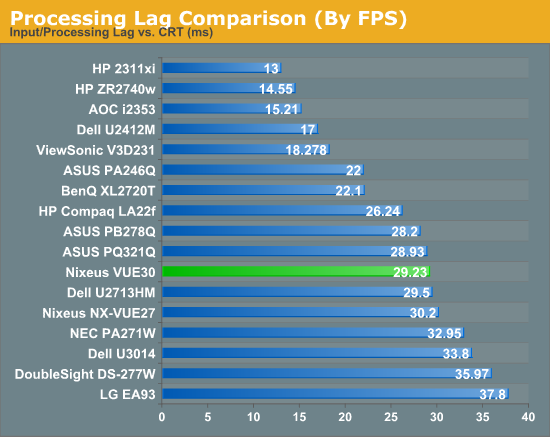
Power use is not a good area for the Nixeus. It is rated for < 130 watts of power consumption on the specs, but my unit managed to use over 150 watts at peak brightness. Since the peak brightness was also almost 75 cd/m2 below the specs, that is a large difference there in the power measurements. A white screen also uses less energy than a black screen with an LCD typically, so I’m not sure what would provide a power measurement that low while running at maximum brightness. Most likely Nixeus is rating power use by how much the display requires and not accounting for the efficiency of the power brick; 85% efficiency at 130W would give us 153W, which is close to what I'm seeing, but it's still quite a bit higher than a modern LED backlit display.
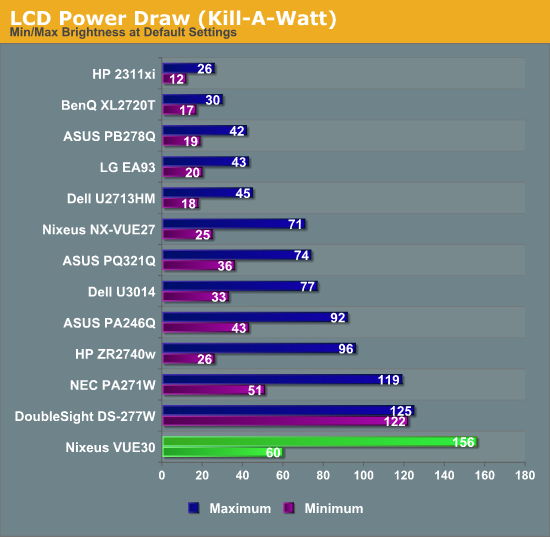
Going down to minimum brightness drops the power use to 60 watts, which is much more reasonable. Using my formula to get candelas per square inch per watt, the Nixeus came in dead last among the displays I have tested. All of the 30” displays do poorly here, as their more complex backlighting systems use a lot more power, but the Nixeus is the worst offender.
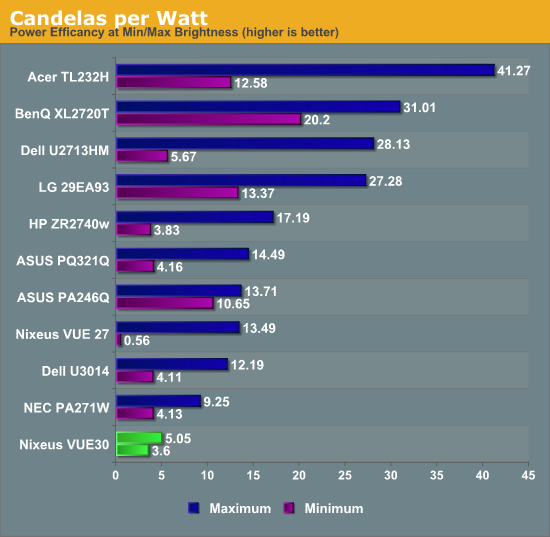
Running the Nixeus profile through Gamutvision, we see 103% coverage of the AdobeRGB gamut. This falls short of some other displays, but still is full coverage and as we saw it works pretty well when in AdobeRGB mode.
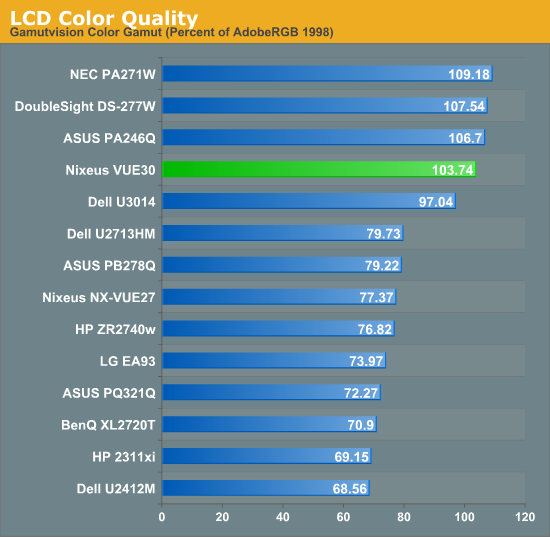
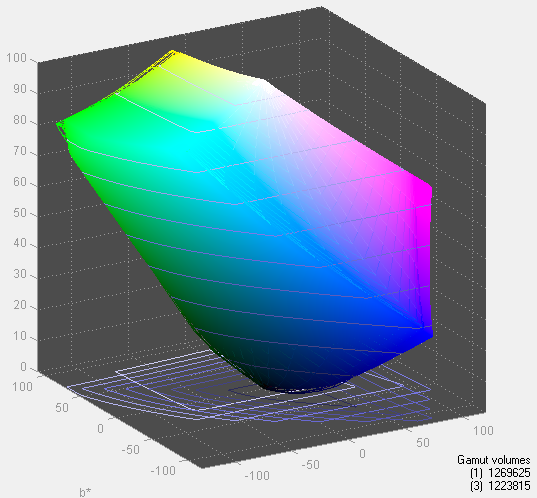


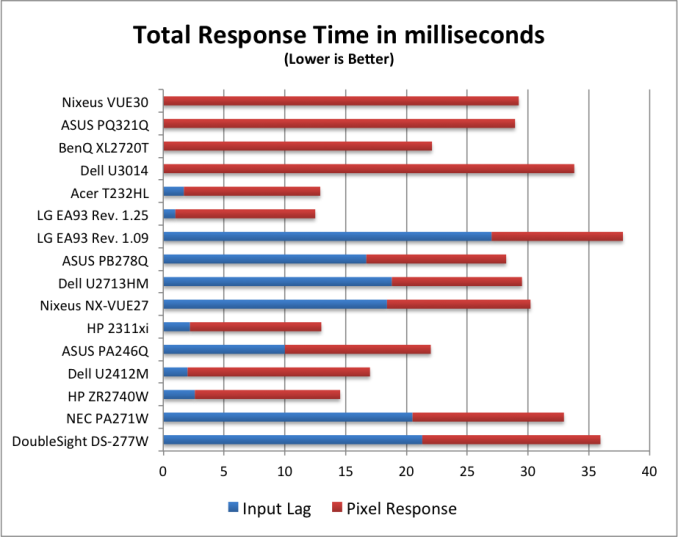








95 Comments
View All Comments
cheinonen - Tuesday, August 20, 2013 - link
I probably need to have a Cut-and-Paste note for the lag section at this point. I was using SMTT which worked reasonably well, but no longer is selling licenses and mine has long expired now. Mirroring a counter can have issues, but the main one is there isn't a CRT I can reasonably buy that does beyond 1920x1200 (since I'm moving into the world of Barco and Sony 9" CRT projectors that cost a ton and take up far too much room) so then I have to scale the video input anyway. All the lag testers, like the Leo Bodnar, are designed around TVs so they cap at 1080p for output right now.Hopefully with 4K TVs coming out there will be someone that makes a lag tester that uses HDMI 1.4a and can run at multiple resolutions, but it doesn't exist yet. All other lag measurement methods use oscilloscopes and custom software, which is beyond what I can manage at the moment. The Leo Bodnar is far from ideal for this, but it's the best of a bad situation. For monitors that allow direct 1:1 input, I always measure that mode and not a scaled mode. Often I find the differences are only 1-2ms, though, so the scaler really isn't adding that much of an impact.
ZeDestructor - Tuesday, August 20, 2013 - link
Thanks for the clarification.That aside, scopes aren't too expensive.. I mean, a bunch of my friends (Uni students) bought a bunch of Rigol scopes (around 300AUD each) just so they didn't have to trek down to uni for working on their projects. Sure, you can get really expensive ones well into the thousands range, but last I checked a few weeks ago from reading TFTCentral's reviews, a USB scope is in the €300 range, which IMO isn't bad at all considering the sheer datalogging you can do from a computer vs an independent scope...
AnnonymousCoward - Thursday, August 22, 2013 - link
Wouldn't you rather have a Copy-and-Paste note? If you Cut you'd lose it after the first usage!piroroadkill - Tuesday, August 20, 2013 - link
It's not cheap enough to make me want to buy it over a 30" Dell.The fit and finish and look of this is so ultra-cheap. A bit of decent quality matte plastic and a stand that isn't terrible wouldn't break the bank, but it would make this look worth the money they're charging.
ZeDestructor - Tuesday, August 20, 2013 - link
TBH, all they really needed to do was skip glossy anything.. a simple, flat, square matte bezel and all would be good in the world...spat55 - Tuesday, August 20, 2013 - link
Funny thing is this has the same OSD as my DGM (Digimate) 27" 1440p monitor. Really nice quality, but I have heard bad things about the power supplies going bang, but I have had mine for 4 months so hopefully I will be good and have a decent batch.coolhardware - Tuesday, August 20, 2013 - link
Crazy timing, I just ordered a 27" 2560x1440 Korean made display last night. It was a hair over $300 at Amazon (shortened URL: http://goo.gl/zU4E3x ) and I was shocked that it was so cheap. It is no frills, with Dual Link DVI as the only interface but that is my preferred interface anyway. :-)As for size:
30" 2560x1600 = 404.49 square inches (25.4″x15.9″)
27" 2560x1440 = 311.5 square inches (23.5″x13.2″)
So for $300 for a 27" model you get 77% of the display area of the $700 30" model... not bad!
(Source: Pixensity.com Desktop LCD List)
After reading this review I am glad that I did not get a 30" Korean model as it looks like there is still some improvements to be made and that price is still very high. I agree with the article and other commenters that a Dell 30" (or similar) may still be preferred and I am looking forward to comparing the new 27" display to my old standby the Dell 3007WFP (from way back in 2005!)
Nfarce - Wednesday, August 21, 2013 - link
Good luck. Those inexpensive Korean knock-offs have a high rate of QC issues, from dust/dirt inside the display to plenty of dead pixels and uneven LCD mounting inside the bezel. I just dropped $699 on an LG 27EA83-D at Fry's and am seriously thinking of returning it and getting a 30" Dell U3014 direct from Dell for $999 on sale all month with a coupon code. The LG is great but not as big a leap from my 24" 1920x1200 Samsung as expected, even with the higher resolution.peterfares - Wednesday, August 21, 2013 - link
I've had a cheapo Korean for over a year now. Paid $290 for it shipped to my door. Sits next to my Dell U3011. Not a single issue. No defective pixels, either.Don't buy a model with edge-to-edge glass and you won't have any dust in your screen. Glass=glare and is stupid anyways.
dlang1234 - Tuesday, August 20, 2013 - link
I don't understand why you haven't tested the MonoPrice version of the monitors considering they are around the same price range.30" IPS Crystal Pro Monitor $797.50
http://www.monoprice.com/products/product.asp?c_id...